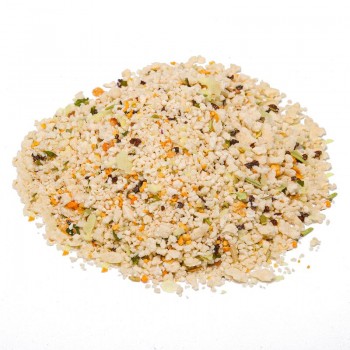A preparation for breading and gratin that combines lemon and pink pepper, which give fruity notes and moderate spiciness, with turmeric and paprika which give balance to the mixture by adding more sour tones.< /p>
Breading or gratin
Breading or gratinating are not the same thing in the kitchen, obviously, in the first case the dish is completely covered before putting it in the oven or frying, in the case of gratin (from the French gratin ) it is instead a cooking technique that aims to develop a crunchy crust on the surface of the dish while keeping the heart of the dish softer and moister. However, the chemical processes responsible for the formation of breading, gratinating and many other things in the kitchen (for example the brown crust that contains certain baked products) are the same, which is why this preparation can be used for both breading and gratinating. For the record: these chemical processes are called the Maillard reaction, named after Louis Camille Maillard, the French doctor and chemist who first investigated them. Maillard wasn't interested in cooking, don't get us thinking about this, but in the synthesis of proteins and he observed how amino acids (building blocks of proteins) interact with sugars. The reaction between proteins and carbohydrates (carbohydrates are complex sugars) is responsible for the formation of the succulent crusts mentioned above. Obviously in the kitchen we don't need to know who Maillard is or go there to study the complex chemical reactions, but keeping in mind that these are proteins that react with carbohydrates yes, we need to understand why we usually add cheese (proteins) to breadcrumbs or to the flour (carbohydrates) when we make a gratin and why we always do it in vegetable gratins or we risk getting charred vegetables instead of the gratin but we can do without them in fish or meat gratins (the proteins are already present in the dish).< /p>
Where to use the lemon and pink pepper gratin breading
Pink pepper, also called false pepper, because it actually comes from a plant native to South America which is not even related to the real pepper, is decidedly less spicy than black pepper and has fruity notes, some say it has a hint of lemon, some say lemongrass, whose flavor is still a bit reminiscent of lemon, it is no coincidence that in English it is called lemon grass and in Asian cuisine it is used a lot in seafood dishes. Pink pepper is therefore used a lot in fish recipes, but also in certain fine meats with a delicate taste such as veal fillet and white meats. By synthesizing pink pepper, it is used on fine dishes to which you want to add something extra but without overwhelming the taste of the dish. This breading by adding turmeric and paprika is a pinch tastier and could also be suitable for giving more flavor to vegetable dishes as well as in combination with white meats.









 No reward points for this product.
No reward points for this product.



![Breadcrumbs with spinach [Natura d'Oriente]](https://www.naturadoriente.com/3400-home_default/breadcrumbs-with-spinach.jpg)











